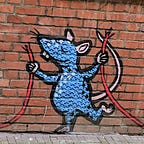Like Tribes
Andrew Sullivan, my favorite conservative pundit, recently left New York magazine to re-start his own blog, now known as the Weekly Dish. The environment at New York grew too woke for him.
So it’s little surprise his first post after leaving is a friendly critique of a book called Cynical Theories: How Activist Scholarship Made Everything About Race, Gender and Identity by James Lindsay and Helen Pluckrose, two of the three scamps behind the Sokal Squared hoax. I’ve found their prose abstruse, so I’m grateful to Sullivan for summarizing their book’s thesis, which I will further summarize for those of you who haven’t had ringside seats to the last two decades of academic food fights.
Critical theory, the rubric under which flourish fields such as critical race theory, queer theory, intersectional feminism, disability studies, and fat studies, began with the Marxist-oriented Frankfurt School in Germany, which sought to understand why working class people sided with fascism rather than communism before and during World War II. A critical theory, as opposed to an ordinary academic theory, is intended to help liberate humankind. As reflected in the work of Erich Fromm, the only Frankfurt School member I’ve read extensively, early critical theory was deeply anti-authoritarian; its goal was to prevent a repeat of the maelstrom just ended.
Infused during the 1950s and 1960s with French social theory, critical theory spun off postmodernism, which starts from the premise that truth is subjective and therefore a matter of individual perception rather than fact — a slippery anti-intellectual slope that, in the wrong hands, can lead to worldviews unmoored from reality. (Not that our society suffers from anything like that.)
Toward the end of the twentieth century postmodernism in turn spun off an updated version of critical theory, premised on the notion that prevailing truths — even scientifically objective ones — are merely tools of the powerful to oppress millions. But where the Frankfurt School distinguished powerful from powerless by economic class, today’s critical theorists distinguish powerful from powerless by group identity. As Sullivan explains, “in this worldview, individuals only exist at all as a place where these group identities intersect . . . . I am never just me. I’m a point where the intersecting identities of white, gay, male, Catholic, immigrant, HIV-positive, cis, and English all somehow collide.”
In addition to erasing the individual, critical theory erases the universal. There is no room for my root assumptions that we’re all vulnerable, that the uncertainty created by said vulnerability is our ultimate shared reality, and that much, perhaps all, of what we do, critical theorizing included, is meant to protect us against each other and the random, indifferent universe.
What we get instead are power struggles between identity groups: men versus women, whites versus people of color, straights versus gays, thin versus fat, etc. And since critical theory aims for liberation, those whose identities hold more power (also known as “privilege”) must yield to those with less.
Which is not an outrageous viewpoint. For instance, it’s true that white people, as a whole, have exercised more control over world affairs during the last few centuries than people of color. That’s not fair, especially because there are more people of color than white people. And that’s just one longstanding unfairness among many. Liberals like Lindsay, Pluckrose, and me agree with critical theorists on the need to correct historical injustices.
Where we differ is how to get there. Liberals favor free discourse, coalition building, and democracy. (Sullivan points to the late John Lewis as a model of this outlook.) The new critical theory is based on a dominance-submission model of human relations and a top-down imposition of values — authoritarianism. Sullivan cites as an example the proposal by Ibram X. Kendi (How to be an Antiracist) to create a federal Department of Antiracism answerable to pretty much no one and, in Kendi’s words, “empowered with disciplinary tools to wield over and against policymakers and public officials who do not voluntarily change their racist policy and ideas.”
America’s right-wing authoritarians are far more threatening than their left-wing counterparts, and are likely to remain so for a long time. But in one respect, right- and left-wing authoritarians are similar: they’re tribalists, seeing people as group members rather than individuals. Critical theory doesn’t reduce suffering, it just redistributes suffering. And that’s not how truly progressive societies advance.
